Taxation Law Assignment: ITAA 1997 and GSTR Act Analysis
VerifiedAdded on 2020/03/07
|12
|2216
|61
Homework Assignment
AI Summary
This taxation law assignment delves into several key issues related to Australian tax law, specifically focusing on the Income Tax Assessment Act 1997 (ITAA 1997) and the Goods and Services Tax Ruling (GSTR) Act 1999. The assignment analyzes four distinct scenarios concerning allowable deductions. The first scenario examines whether the cost of moving machinery to a new site constitutes an allowable deduction, concluding that it is capital expenditure and thus not deductible. The second issue addresses whether the revaluation of assets for insurance purposes qualifies for deductions, concluding that it is allowable due to its recurring nature. The third scenario explores the deductibility of legal expenses incurred to oppose a company winding-up petition, determining that such expenses are not deductible as they are capital in nature. The fourth scenario assesses the deductibility of legal expenses for various business operations, concluding that they are allowable. The assignment also analyzes a second question related to input tax credits for advertising expenditure under the GSTR Act 1999, concluding that the entity is entitled to claim input tax credits. The analysis references relevant legislation, taxation rulings, and case law to support its conclusions.
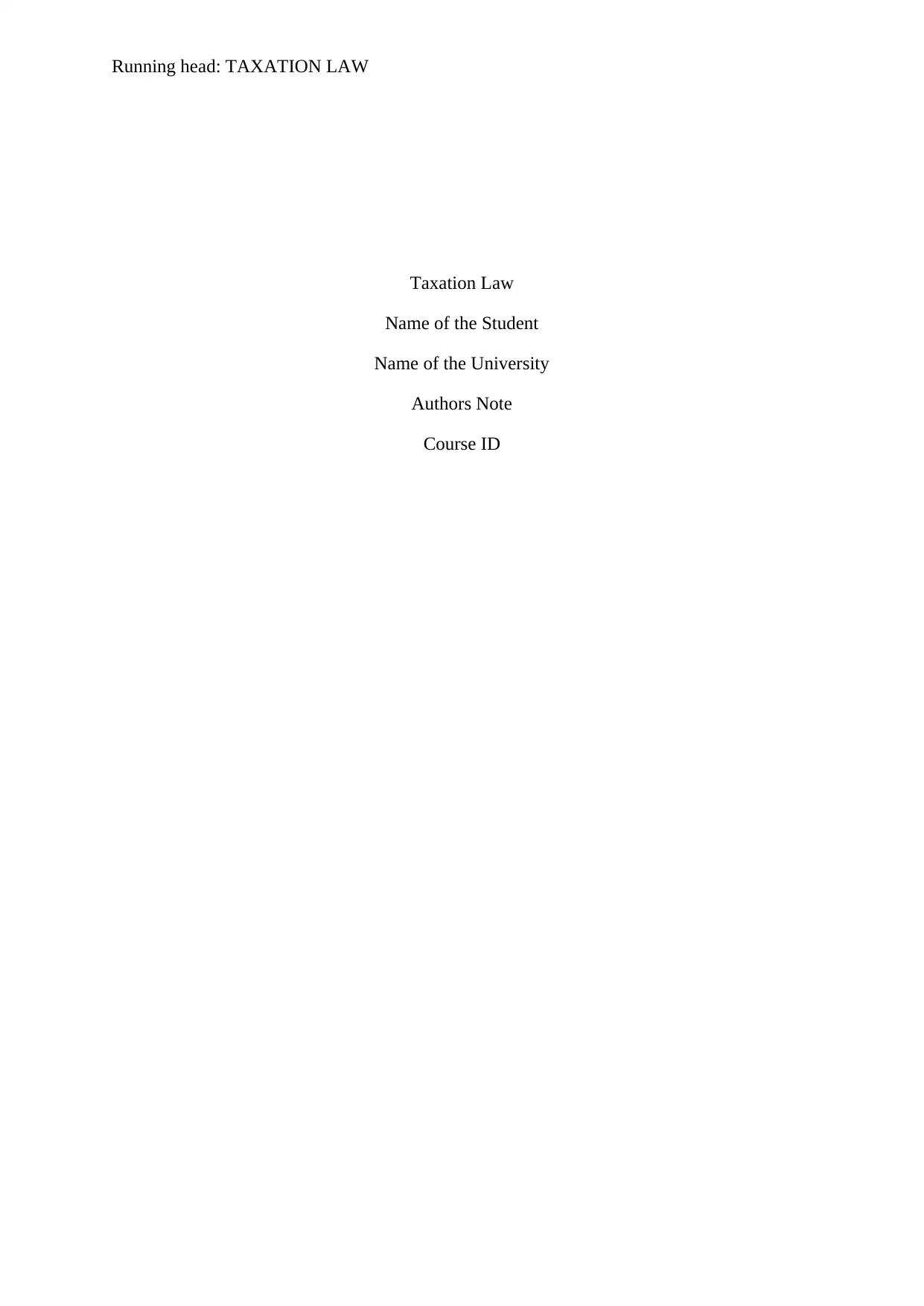
Running head: TAXATION LAW
Taxation Law
Name of the Student
Name of the University
Authors Note
Course ID
Taxation Law
Name of the Student
Name of the University
Authors Note
Course ID
Paraphrase This Document
Need a fresh take? Get an instant paraphrase of this document with our AI Paraphraser
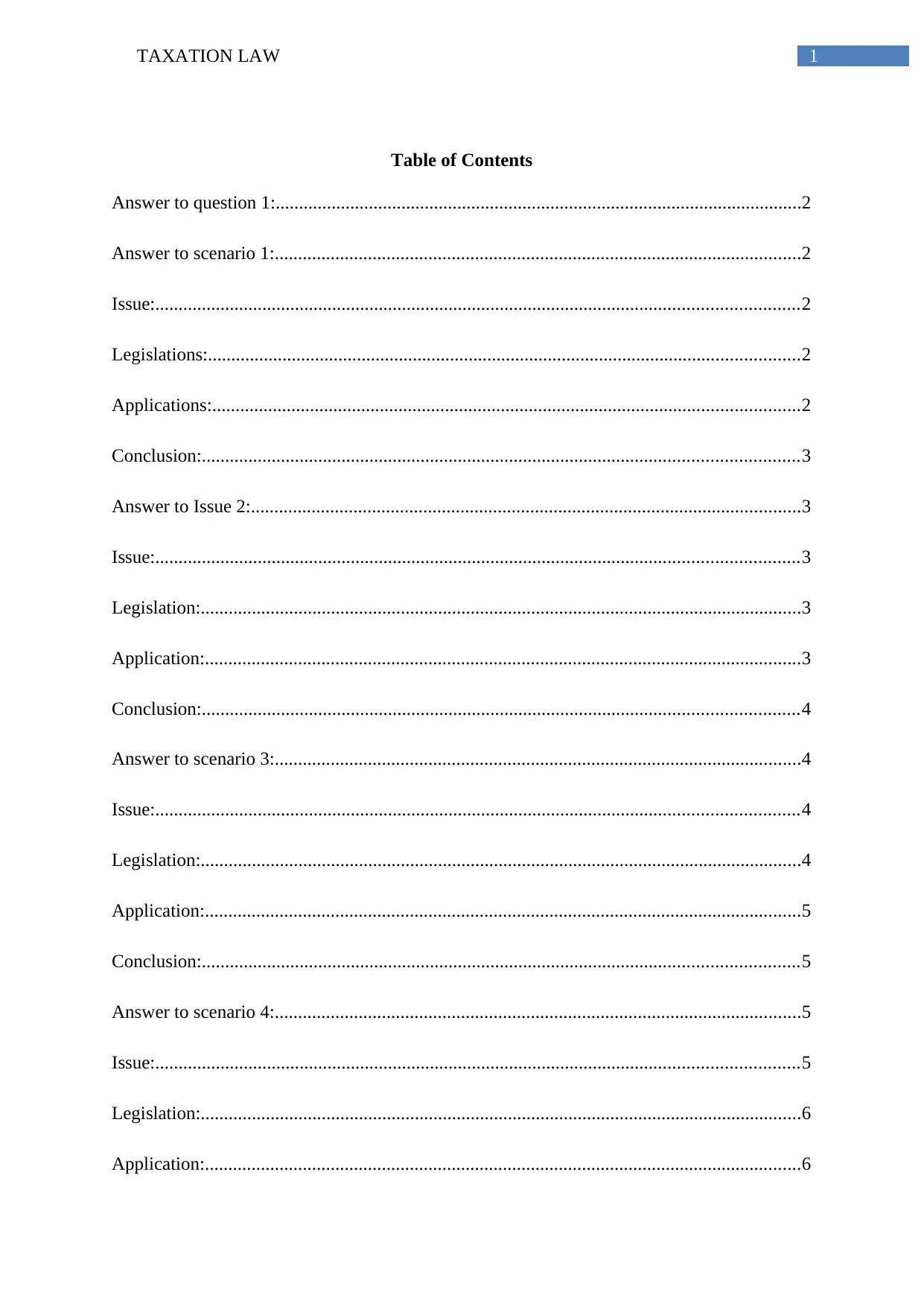
1TAXATION LAW
Table of Contents
Answer to question 1:.................................................................................................................2
Answer to scenario 1:.................................................................................................................2
Issue:..........................................................................................................................................2
Legislations:...............................................................................................................................2
Applications:..............................................................................................................................2
Conclusion:................................................................................................................................3
Answer to Issue 2:......................................................................................................................3
Issue:..........................................................................................................................................3
Legislation:.................................................................................................................................3
Application:................................................................................................................................3
Conclusion:................................................................................................................................4
Answer to scenario 3:.................................................................................................................4
Issue:..........................................................................................................................................4
Legislation:.................................................................................................................................4
Application:................................................................................................................................5
Conclusion:................................................................................................................................5
Answer to scenario 4:.................................................................................................................5
Issue:..........................................................................................................................................5
Legislation:.................................................................................................................................6
Application:................................................................................................................................6
Table of Contents
Answer to question 1:.................................................................................................................2
Answer to scenario 1:.................................................................................................................2
Issue:..........................................................................................................................................2
Legislations:...............................................................................................................................2
Applications:..............................................................................................................................2
Conclusion:................................................................................................................................3
Answer to Issue 2:......................................................................................................................3
Issue:..........................................................................................................................................3
Legislation:.................................................................................................................................3
Application:................................................................................................................................3
Conclusion:................................................................................................................................4
Answer to scenario 3:.................................................................................................................4
Issue:..........................................................................................................................................4
Legislation:.................................................................................................................................4
Application:................................................................................................................................5
Conclusion:................................................................................................................................5
Answer to scenario 4:.................................................................................................................5
Issue:..........................................................................................................................................5
Legislation:.................................................................................................................................6
Application:................................................................................................................................6
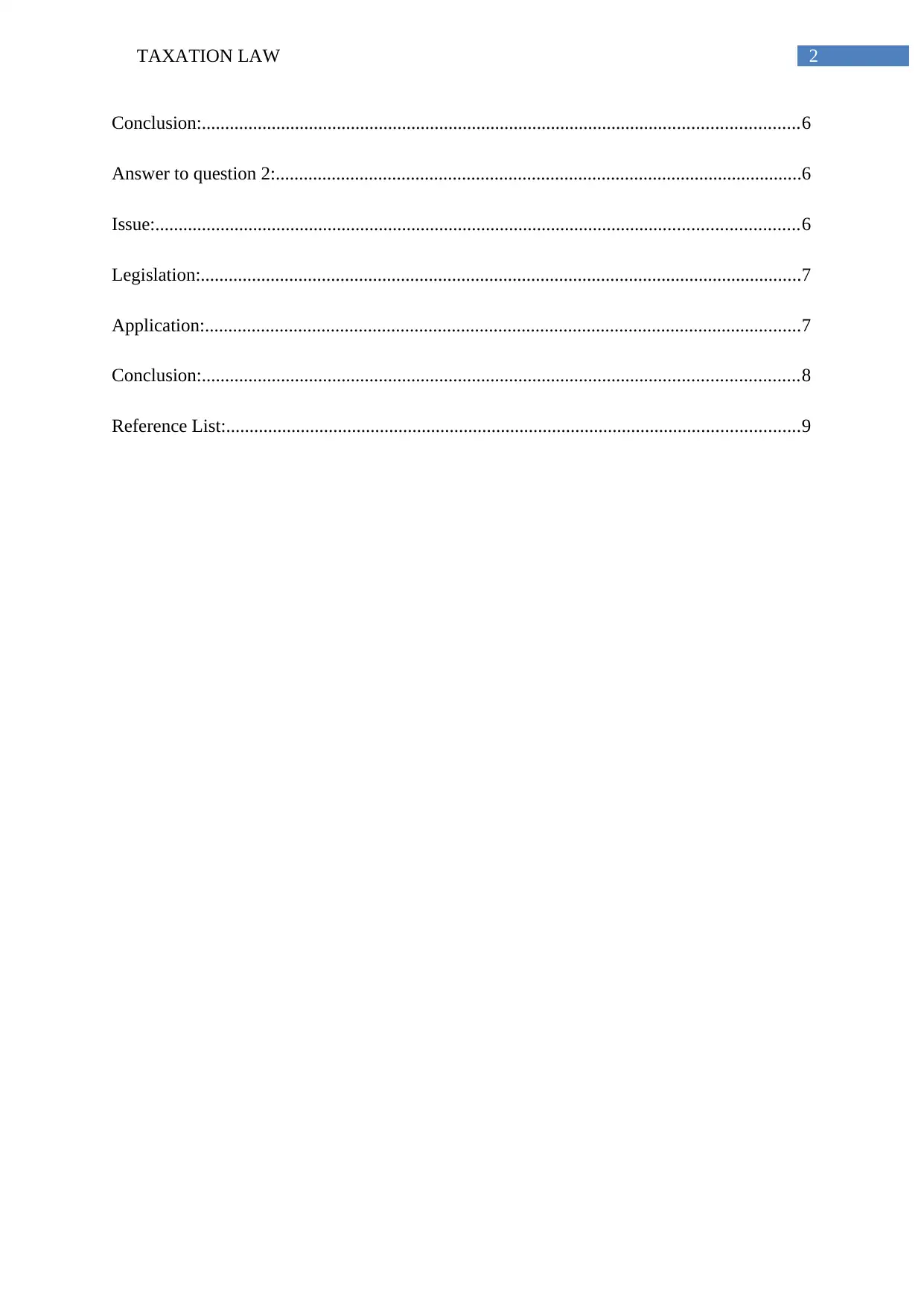
2TAXATION LAW
Conclusion:................................................................................................................................6
Answer to question 2:.................................................................................................................6
Issue:..........................................................................................................................................6
Legislation:.................................................................................................................................7
Application:................................................................................................................................7
Conclusion:................................................................................................................................8
Reference List:...........................................................................................................................9
Conclusion:................................................................................................................................6
Answer to question 2:.................................................................................................................6
Issue:..........................................................................................................................................6
Legislation:.................................................................................................................................7
Application:................................................................................................................................7
Conclusion:................................................................................................................................8
Reference List:...........................................................................................................................9
⊘ This is a preview!⊘
Do you want full access?
Subscribe today to unlock all pages.

Trusted by 1+ million students worldwide
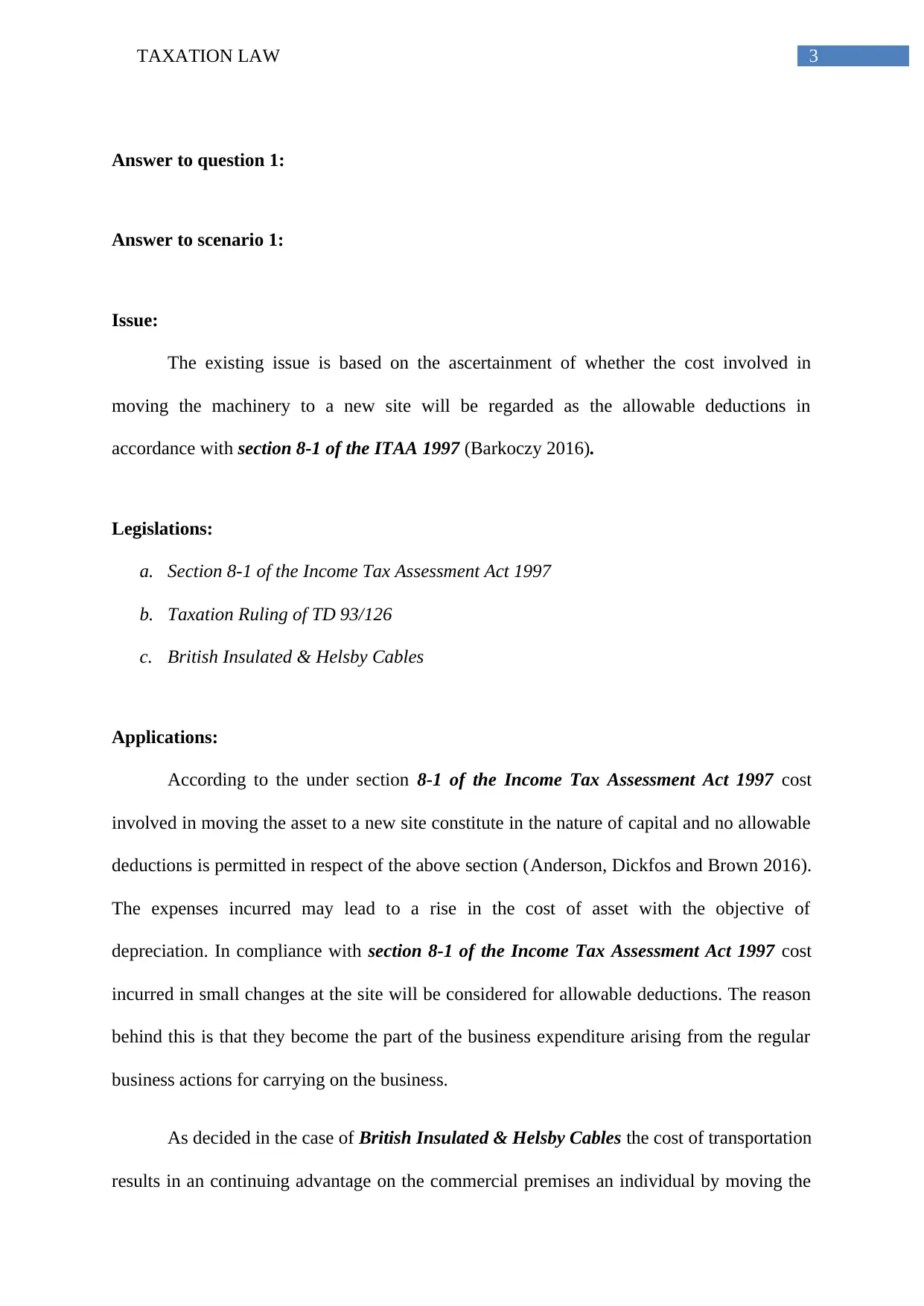
3TAXATION LAW
Answer to question 1:
Answer to scenario 1:
Issue:
The existing issue is based on the ascertainment of whether the cost involved in
moving the machinery to a new site will be regarded as the allowable deductions in
accordance with section 8-1 of the ITAA 1997 (Barkoczy 2016).
Legislations:
a. Section 8-1 of the Income Tax Assessment Act 1997
b. Taxation Ruling of TD 93/126
c. British Insulated & Helsby Cables
Applications:
According to the under section 8-1 of the Income Tax Assessment Act 1997 cost
involved in moving the asset to a new site constitute in the nature of capital and no allowable
deductions is permitted in respect of the above section (Anderson, Dickfos and Brown 2016).
The expenses incurred may lead to a rise in the cost of asset with the objective of
depreciation. In compliance with section 8-1 of the Income Tax Assessment Act 1997 cost
incurred in small changes at the site will be considered for allowable deductions. The reason
behind this is that they become the part of the business expenditure arising from the regular
business actions for carrying on the business.
As decided in the case of British Insulated & Helsby Cables the cost of transportation
results in an continuing advantage on the commercial premises an individual by moving the
Answer to question 1:
Answer to scenario 1:
Issue:
The existing issue is based on the ascertainment of whether the cost involved in
moving the machinery to a new site will be regarded as the allowable deductions in
accordance with section 8-1 of the ITAA 1997 (Barkoczy 2016).
Legislations:
a. Section 8-1 of the Income Tax Assessment Act 1997
b. Taxation Ruling of TD 93/126
c. British Insulated & Helsby Cables
Applications:
According to the under section 8-1 of the Income Tax Assessment Act 1997 cost
involved in moving the asset to a new site constitute in the nature of capital and no allowable
deductions is permitted in respect of the above section (Anderson, Dickfos and Brown 2016).
The expenses incurred may lead to a rise in the cost of asset with the objective of
depreciation. In compliance with section 8-1 of the Income Tax Assessment Act 1997 cost
incurred in small changes at the site will be considered for allowable deductions. The reason
behind this is that they become the part of the business expenditure arising from the regular
business actions for carrying on the business.
As decided in the case of British Insulated & Helsby Cables the cost of transportation
results in an continuing advantage on the commercial premises an individual by moving the
Paraphrase This Document
Need a fresh take? Get an instant paraphrase of this document with our AI Paraphraser
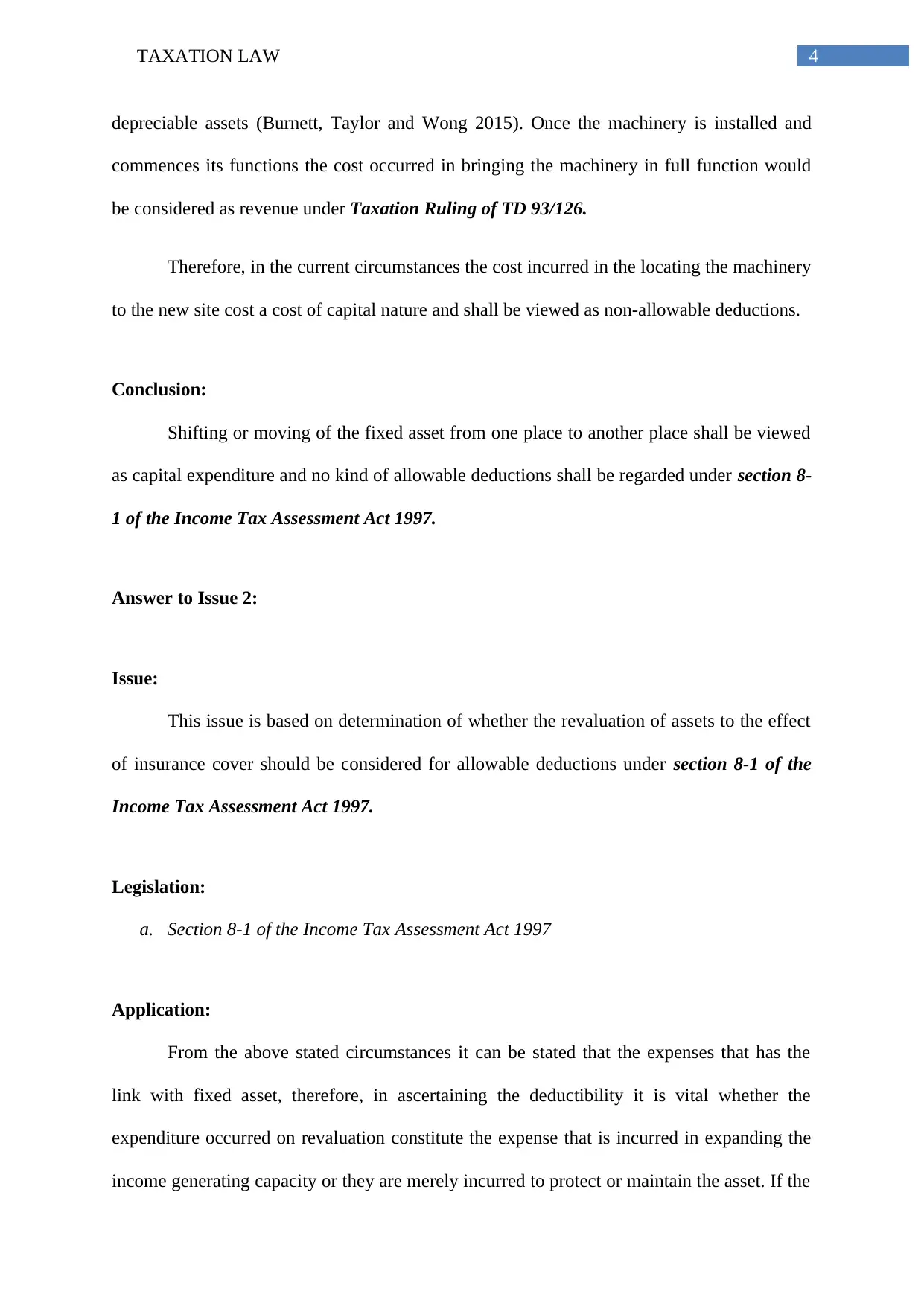
4TAXATION LAW
depreciable assets (Burnett, Taylor and Wong 2015). Once the machinery is installed and
commences its functions the cost occurred in bringing the machinery in full function would
be considered as revenue under Taxation Ruling of TD 93/126.
Therefore, in the current circumstances the cost incurred in the locating the machinery
to the new site cost a cost of capital nature and shall be viewed as non-allowable deductions.
Conclusion:
Shifting or moving of the fixed asset from one place to another place shall be viewed
as capital expenditure and no kind of allowable deductions shall be regarded under section 8-
1 of the Income Tax Assessment Act 1997.
Answer to Issue 2:
Issue:
This issue is based on determination of whether the revaluation of assets to the effect
of insurance cover should be considered for allowable deductions under section 8-1 of the
Income Tax Assessment Act 1997.
Legislation:
a. Section 8-1 of the Income Tax Assessment Act 1997
Application:
From the above stated circumstances it can be stated that the expenses that has the
link with fixed asset, therefore, in ascertaining the deductibility it is vital whether the
expenditure occurred on revaluation constitute the expense that is incurred in expanding the
income generating capacity or they are merely incurred to protect or maintain the asset. If the
depreciable assets (Burnett, Taylor and Wong 2015). Once the machinery is installed and
commences its functions the cost occurred in bringing the machinery in full function would
be considered as revenue under Taxation Ruling of TD 93/126.
Therefore, in the current circumstances the cost incurred in the locating the machinery
to the new site cost a cost of capital nature and shall be viewed as non-allowable deductions.
Conclusion:
Shifting or moving of the fixed asset from one place to another place shall be viewed
as capital expenditure and no kind of allowable deductions shall be regarded under section 8-
1 of the Income Tax Assessment Act 1997.
Answer to Issue 2:
Issue:
This issue is based on determination of whether the revaluation of assets to the effect
of insurance cover should be considered for allowable deductions under section 8-1 of the
Income Tax Assessment Act 1997.
Legislation:
a. Section 8-1 of the Income Tax Assessment Act 1997
Application:
From the above stated circumstances it can be stated that the expenses that has the
link with fixed asset, therefore, in ascertaining the deductibility it is vital whether the
expenditure occurred on revaluation constitute the expense that is incurred in expanding the
income generating capacity or they are merely incurred to protect or maintain the asset. If the
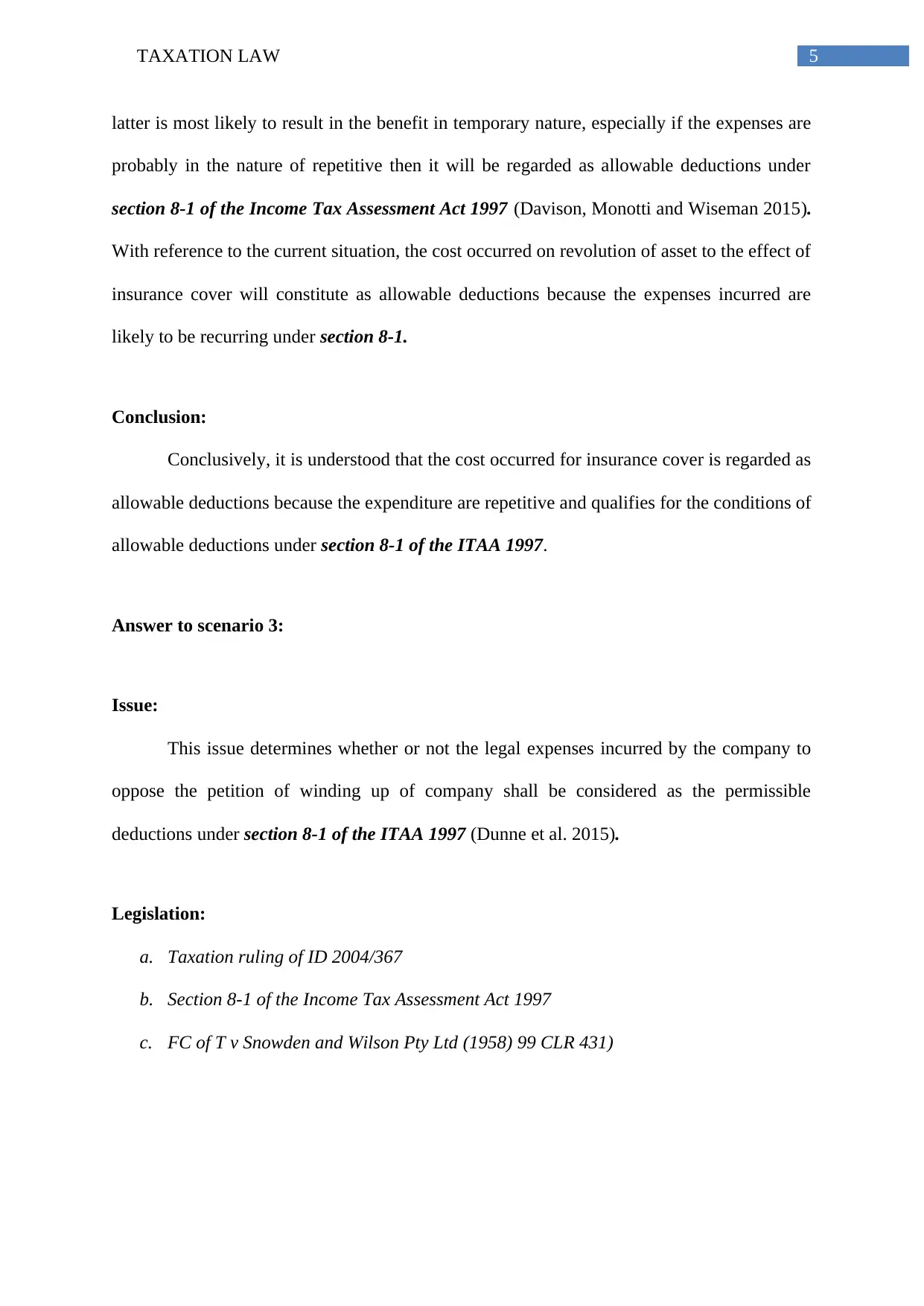
5TAXATION LAW
latter is most likely to result in the benefit in temporary nature, especially if the expenses are
probably in the nature of repetitive then it will be regarded as allowable deductions under
section 8-1 of the Income Tax Assessment Act 1997 (Davison, Monotti and Wiseman 2015).
With reference to the current situation, the cost occurred on revolution of asset to the effect of
insurance cover will constitute as allowable deductions because the expenses incurred are
likely to be recurring under section 8-1.
Conclusion:
Conclusively, it is understood that the cost occurred for insurance cover is regarded as
allowable deductions because the expenditure are repetitive and qualifies for the conditions of
allowable deductions under section 8-1 of the ITAA 1997.
Answer to scenario 3:
Issue:
This issue determines whether or not the legal expenses incurred by the company to
oppose the petition of winding up of company shall be considered as the permissible
deductions under section 8-1 of the ITAA 1997 (Dunne et al. 2015).
Legislation:
a. Taxation ruling of ID 2004/367
b. Section 8-1 of the Income Tax Assessment Act 1997
c. FC of T v Snowden and Wilson Pty Ltd (1958) 99 CLR 431)
latter is most likely to result in the benefit in temporary nature, especially if the expenses are
probably in the nature of repetitive then it will be regarded as allowable deductions under
section 8-1 of the Income Tax Assessment Act 1997 (Davison, Monotti and Wiseman 2015).
With reference to the current situation, the cost occurred on revolution of asset to the effect of
insurance cover will constitute as allowable deductions because the expenses incurred are
likely to be recurring under section 8-1.
Conclusion:
Conclusively, it is understood that the cost occurred for insurance cover is regarded as
allowable deductions because the expenditure are repetitive and qualifies for the conditions of
allowable deductions under section 8-1 of the ITAA 1997.
Answer to scenario 3:
Issue:
This issue determines whether or not the legal expenses incurred by the company to
oppose the petition of winding up of company shall be considered as the permissible
deductions under section 8-1 of the ITAA 1997 (Dunne et al. 2015).
Legislation:
a. Taxation ruling of ID 2004/367
b. Section 8-1 of the Income Tax Assessment Act 1997
c. FC of T v Snowden and Wilson Pty Ltd (1958) 99 CLR 431)
⊘ This is a preview!⊘
Do you want full access?
Subscribe today to unlock all pages.

Trusted by 1+ million students worldwide
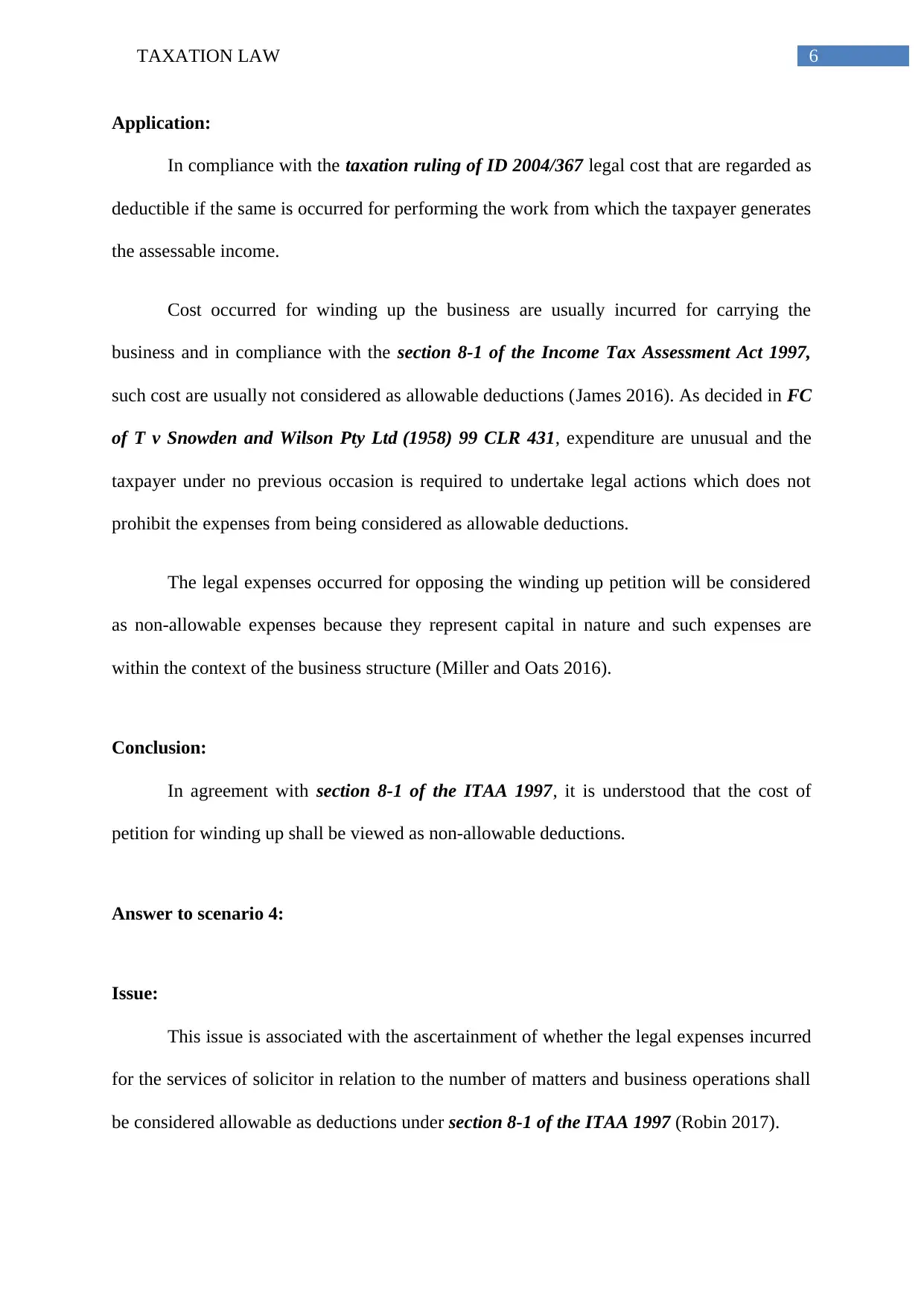
6TAXATION LAW
Application:
In compliance with the taxation ruling of ID 2004/367 legal cost that are regarded as
deductible if the same is occurred for performing the work from which the taxpayer generates
the assessable income.
Cost occurred for winding up the business are usually incurred for carrying the
business and in compliance with the section 8-1 of the Income Tax Assessment Act 1997,
such cost are usually not considered as allowable deductions (James 2016). As decided in FC
of T v Snowden and Wilson Pty Ltd (1958) 99 CLR 431, expenditure are unusual and the
taxpayer under no previous occasion is required to undertake legal actions which does not
prohibit the expenses from being considered as allowable deductions.
The legal expenses occurred for opposing the winding up petition will be considered
as non-allowable expenses because they represent capital in nature and such expenses are
within the context of the business structure (Miller and Oats 2016).
Conclusion:
In agreement with section 8-1 of the ITAA 1997, it is understood that the cost of
petition for winding up shall be viewed as non-allowable deductions.
Answer to scenario 4:
Issue:
This issue is associated with the ascertainment of whether the legal expenses incurred
for the services of solicitor in relation to the number of matters and business operations shall
be considered allowable as deductions under section 8-1 of the ITAA 1997 (Robin 2017).
Application:
In compliance with the taxation ruling of ID 2004/367 legal cost that are regarded as
deductible if the same is occurred for performing the work from which the taxpayer generates
the assessable income.
Cost occurred for winding up the business are usually incurred for carrying the
business and in compliance with the section 8-1 of the Income Tax Assessment Act 1997,
such cost are usually not considered as allowable deductions (James 2016). As decided in FC
of T v Snowden and Wilson Pty Ltd (1958) 99 CLR 431, expenditure are unusual and the
taxpayer under no previous occasion is required to undertake legal actions which does not
prohibit the expenses from being considered as allowable deductions.
The legal expenses occurred for opposing the winding up petition will be considered
as non-allowable expenses because they represent capital in nature and such expenses are
within the context of the business structure (Miller and Oats 2016).
Conclusion:
In agreement with section 8-1 of the ITAA 1997, it is understood that the cost of
petition for winding up shall be viewed as non-allowable deductions.
Answer to scenario 4:
Issue:
This issue is associated with the ascertainment of whether the legal expenses incurred
for the services of solicitor in relation to the number of matters and business operations shall
be considered allowable as deductions under section 8-1 of the ITAA 1997 (Robin 2017).
Paraphrase This Document
Need a fresh take? Get an instant paraphrase of this document with our AI Paraphraser
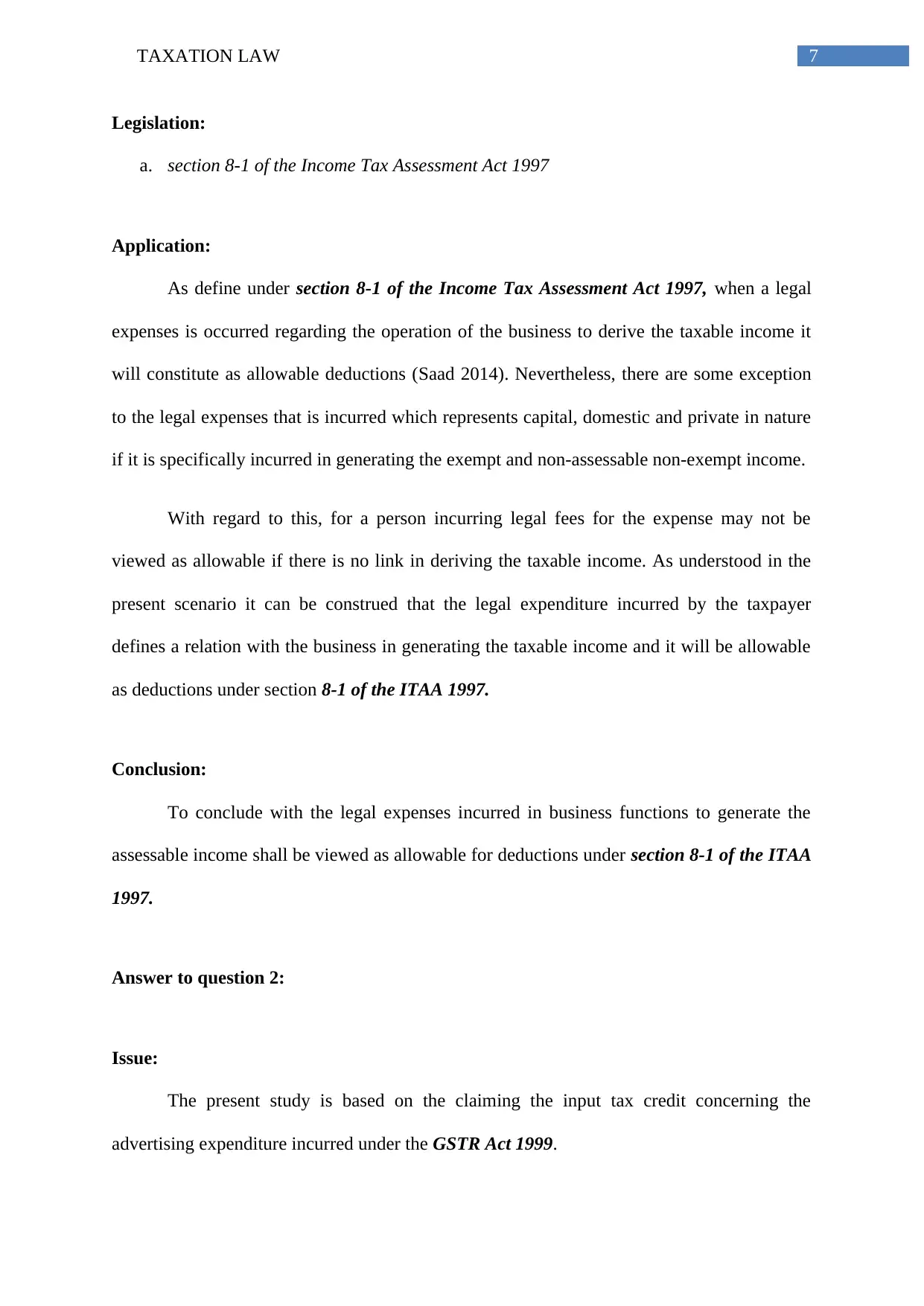
7TAXATION LAW
Legislation:
a. section 8-1 of the Income Tax Assessment Act 1997
Application:
As define under section 8-1 of the Income Tax Assessment Act 1997, when a legal
expenses is occurred regarding the operation of the business to derive the taxable income it
will constitute as allowable deductions (Saad 2014). Nevertheless, there are some exception
to the legal expenses that is incurred which represents capital, domestic and private in nature
if it is specifically incurred in generating the exempt and non-assessable non-exempt income.
With regard to this, for a person incurring legal fees for the expense may not be
viewed as allowable if there is no link in deriving the taxable income. As understood in the
present scenario it can be construed that the legal expenditure incurred by the taxpayer
defines a relation with the business in generating the taxable income and it will be allowable
as deductions under section 8-1 of the ITAA 1997.
Conclusion:
To conclude with the legal expenses incurred in business functions to generate the
assessable income shall be viewed as allowable for deductions under section 8-1 of the ITAA
1997.
Answer to question 2:
Issue:
The present study is based on the claiming the input tax credit concerning the
advertising expenditure incurred under the GSTR Act 1999.
Legislation:
a. section 8-1 of the Income Tax Assessment Act 1997
Application:
As define under section 8-1 of the Income Tax Assessment Act 1997, when a legal
expenses is occurred regarding the operation of the business to derive the taxable income it
will constitute as allowable deductions (Saad 2014). Nevertheless, there are some exception
to the legal expenses that is incurred which represents capital, domestic and private in nature
if it is specifically incurred in generating the exempt and non-assessable non-exempt income.
With regard to this, for a person incurring legal fees for the expense may not be
viewed as allowable if there is no link in deriving the taxable income. As understood in the
present scenario it can be construed that the legal expenditure incurred by the taxpayer
defines a relation with the business in generating the taxable income and it will be allowable
as deductions under section 8-1 of the ITAA 1997.
Conclusion:
To conclude with the legal expenses incurred in business functions to generate the
assessable income shall be viewed as allowable for deductions under section 8-1 of the ITAA
1997.
Answer to question 2:
Issue:
The present study is based on the claiming the input tax credit concerning the
advertising expenditure incurred under the GSTR Act 1999.
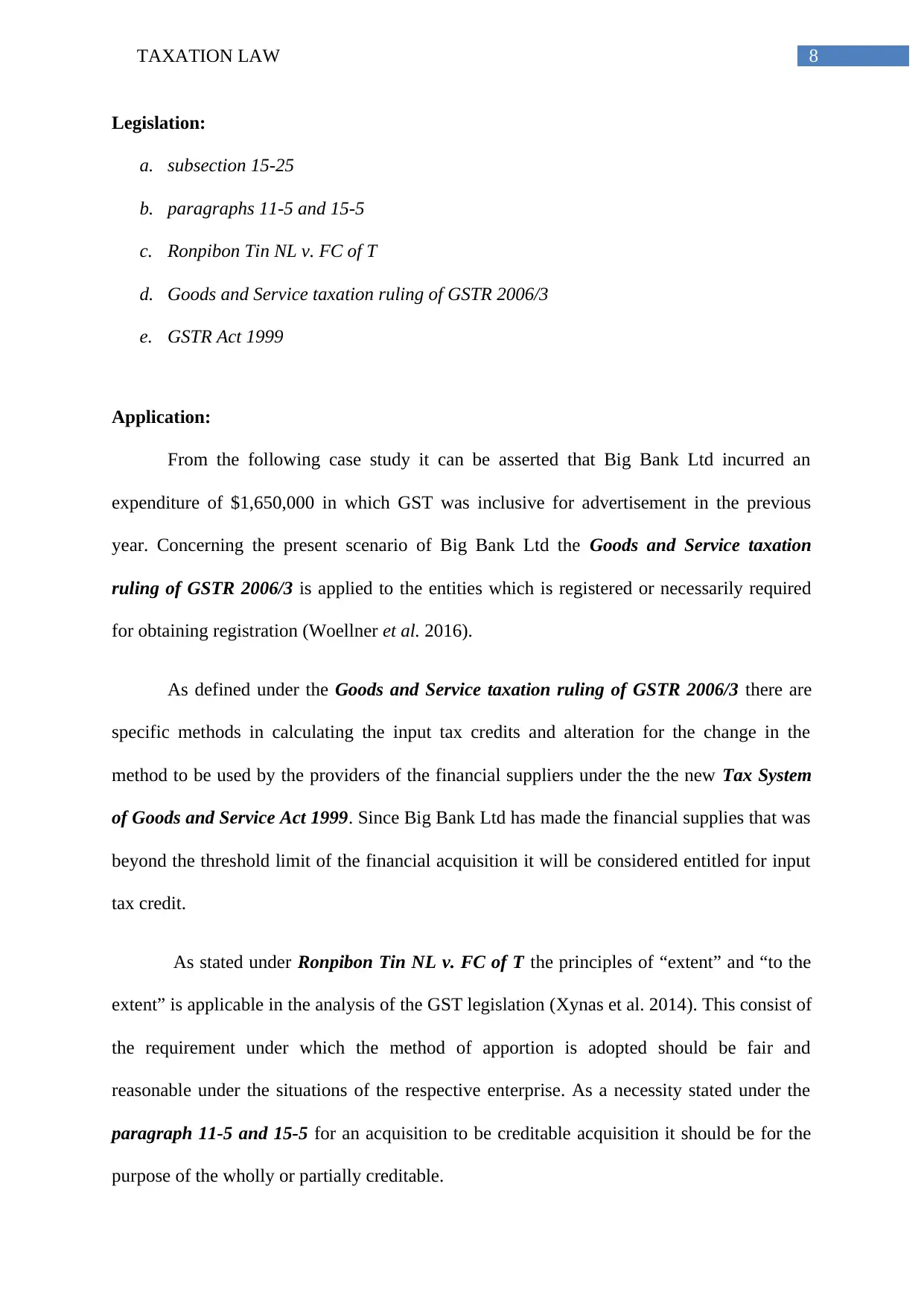
8TAXATION LAW
Legislation:
a. subsection 15-25
b. paragraphs 11-5 and 15-5
c. Ronpibon Tin NL v. FC of T
d. Goods and Service taxation ruling of GSTR 2006/3
e. GSTR Act 1999
Application:
From the following case study it can be asserted that Big Bank Ltd incurred an
expenditure of $1,650,000 in which GST was inclusive for advertisement in the previous
year. Concerning the present scenario of Big Bank Ltd the Goods and Service taxation
ruling of GSTR 2006/3 is applied to the entities which is registered or necessarily required
for obtaining registration (Woellner et al. 2016).
As defined under the Goods and Service taxation ruling of GSTR 2006/3 there are
specific methods in calculating the input tax credits and alteration for the change in the
method to be used by the providers of the financial suppliers under the the new Tax System
of Goods and Service Act 1999. Since Big Bank Ltd has made the financial supplies that was
beyond the threshold limit of the financial acquisition it will be considered entitled for input
tax credit.
As stated under Ronpibon Tin NL v. FC of T the principles of “extent” and “to the
extent” is applicable in the analysis of the GST legislation (Xynas et al. 2014). This consist of
the requirement under which the method of apportion is adopted should be fair and
reasonable under the situations of the respective enterprise. As a necessity stated under the
paragraph 11-5 and 15-5 for an acquisition to be creditable acquisition it should be for the
purpose of the wholly or partially creditable.
Legislation:
a. subsection 15-25
b. paragraphs 11-5 and 15-5
c. Ronpibon Tin NL v. FC of T
d. Goods and Service taxation ruling of GSTR 2006/3
e. GSTR Act 1999
Application:
From the following case study it can be asserted that Big Bank Ltd incurred an
expenditure of $1,650,000 in which GST was inclusive for advertisement in the previous
year. Concerning the present scenario of Big Bank Ltd the Goods and Service taxation
ruling of GSTR 2006/3 is applied to the entities which is registered or necessarily required
for obtaining registration (Woellner et al. 2016).
As defined under the Goods and Service taxation ruling of GSTR 2006/3 there are
specific methods in calculating the input tax credits and alteration for the change in the
method to be used by the providers of the financial suppliers under the the new Tax System
of Goods and Service Act 1999. Since Big Bank Ltd has made the financial supplies that was
beyond the threshold limit of the financial acquisition it will be considered entitled for input
tax credit.
As stated under Ronpibon Tin NL v. FC of T the principles of “extent” and “to the
extent” is applicable in the analysis of the GST legislation (Xynas et al. 2014). This consist of
the requirement under which the method of apportion is adopted should be fair and
reasonable under the situations of the respective enterprise. As a necessity stated under the
paragraph 11-5 and 15-5 for an acquisition to be creditable acquisition it should be for the
purpose of the wholly or partially creditable.
⊘ This is a preview!⊘
Do you want full access?
Subscribe today to unlock all pages.

Trusted by 1+ million students worldwide
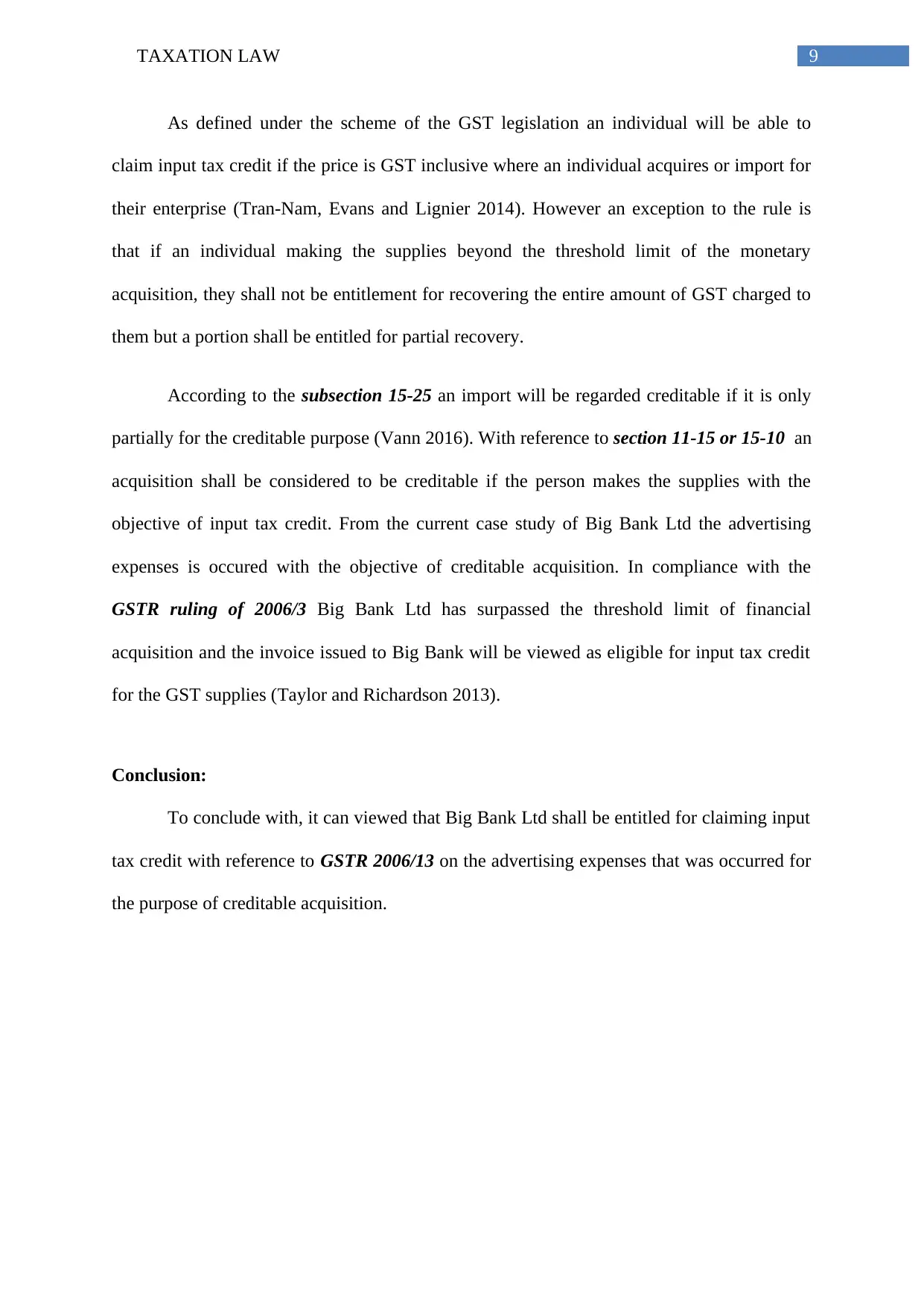
9TAXATION LAW
As defined under the scheme of the GST legislation an individual will be able to
claim input tax credit if the price is GST inclusive where an individual acquires or import for
their enterprise (Tran-Nam, Evans and Lignier 2014). However an exception to the rule is
that if an individual making the supplies beyond the threshold limit of the monetary
acquisition, they shall not be entitlement for recovering the entire amount of GST charged to
them but a portion shall be entitled for partial recovery.
According to the subsection 15-25 an import will be regarded creditable if it is only
partially for the creditable purpose (Vann 2016). With reference to section 11-15 or 15-10 an
acquisition shall be considered to be creditable if the person makes the supplies with the
objective of input tax credit. From the current case study of Big Bank Ltd the advertising
expenses is occured with the objective of creditable acquisition. In compliance with the
GSTR ruling of 2006/3 Big Bank Ltd has surpassed the threshold limit of financial
acquisition and the invoice issued to Big Bank will be viewed as eligible for input tax credit
for the GST supplies (Taylor and Richardson 2013).
Conclusion:
To conclude with, it can viewed that Big Bank Ltd shall be entitled for claiming input
tax credit with reference to GSTR 2006/13 on the advertising expenses that was occurred for
the purpose of creditable acquisition.
As defined under the scheme of the GST legislation an individual will be able to
claim input tax credit if the price is GST inclusive where an individual acquires or import for
their enterprise (Tran-Nam, Evans and Lignier 2014). However an exception to the rule is
that if an individual making the supplies beyond the threshold limit of the monetary
acquisition, they shall not be entitlement for recovering the entire amount of GST charged to
them but a portion shall be entitled for partial recovery.
According to the subsection 15-25 an import will be regarded creditable if it is only
partially for the creditable purpose (Vann 2016). With reference to section 11-15 or 15-10 an
acquisition shall be considered to be creditable if the person makes the supplies with the
objective of input tax credit. From the current case study of Big Bank Ltd the advertising
expenses is occured with the objective of creditable acquisition. In compliance with the
GSTR ruling of 2006/3 Big Bank Ltd has surpassed the threshold limit of financial
acquisition and the invoice issued to Big Bank will be viewed as eligible for input tax credit
for the GST supplies (Taylor and Richardson 2013).
Conclusion:
To conclude with, it can viewed that Big Bank Ltd shall be entitled for claiming input
tax credit with reference to GSTR 2006/13 on the advertising expenses that was occurred for
the purpose of creditable acquisition.
Paraphrase This Document
Need a fresh take? Get an instant paraphrase of this document with our AI Paraphraser
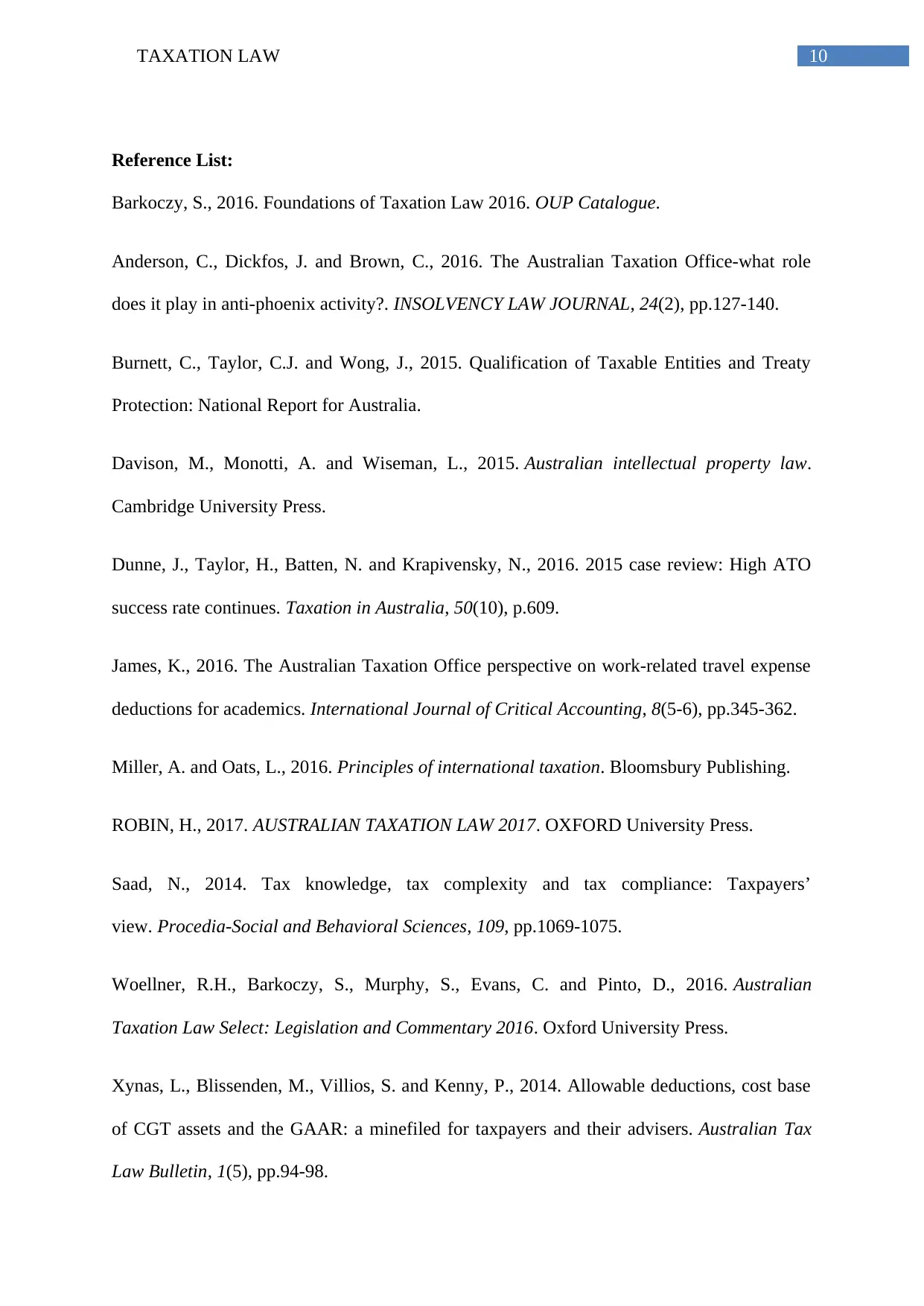
10TAXATION LAW
Reference List:
Barkoczy, S., 2016. Foundations of Taxation Law 2016. OUP Catalogue.
Anderson, C., Dickfos, J. and Brown, C., 2016. The Australian Taxation Office-what role
does it play in anti-phoenix activity?. INSOLVENCY LAW JOURNAL, 24(2), pp.127-140.
Burnett, C., Taylor, C.J. and Wong, J., 2015. Qualification of Taxable Entities and Treaty
Protection: National Report for Australia.
Davison, M., Monotti, A. and Wiseman, L., 2015. Australian intellectual property law.
Cambridge University Press.
Dunne, J., Taylor, H., Batten, N. and Krapivensky, N., 2016. 2015 case review: High ATO
success rate continues. Taxation in Australia, 50(10), p.609.
James, K., 2016. The Australian Taxation Office perspective on work-related travel expense
deductions for academics. International Journal of Critical Accounting, 8(5-6), pp.345-362.
Miller, A. and Oats, L., 2016. Principles of international taxation. Bloomsbury Publishing.
ROBIN, H., 2017. AUSTRALIAN TAXATION LAW 2017. OXFORD University Press.
Saad, N., 2014. Tax knowledge, tax complexity and tax compliance: Taxpayers’
view. Procedia-Social and Behavioral Sciences, 109, pp.1069-1075.
Woellner, R.H., Barkoczy, S., Murphy, S., Evans, C. and Pinto, D., 2016. Australian
Taxation Law Select: Legislation and Commentary 2016. Oxford University Press.
Xynas, L., Blissenden, M., Villios, S. and Kenny, P., 2014. Allowable deductions, cost base
of CGT assets and the GAAR: a minefiled for taxpayers and their advisers. Australian Tax
Law Bulletin, 1(5), pp.94-98.
Reference List:
Barkoczy, S., 2016. Foundations of Taxation Law 2016. OUP Catalogue.
Anderson, C., Dickfos, J. and Brown, C., 2016. The Australian Taxation Office-what role
does it play in anti-phoenix activity?. INSOLVENCY LAW JOURNAL, 24(2), pp.127-140.
Burnett, C., Taylor, C.J. and Wong, J., 2015. Qualification of Taxable Entities and Treaty
Protection: National Report for Australia.
Davison, M., Monotti, A. and Wiseman, L., 2015. Australian intellectual property law.
Cambridge University Press.
Dunne, J., Taylor, H., Batten, N. and Krapivensky, N., 2016. 2015 case review: High ATO
success rate continues. Taxation in Australia, 50(10), p.609.
James, K., 2016. The Australian Taxation Office perspective on work-related travel expense
deductions for academics. International Journal of Critical Accounting, 8(5-6), pp.345-362.
Miller, A. and Oats, L., 2016. Principles of international taxation. Bloomsbury Publishing.
ROBIN, H., 2017. AUSTRALIAN TAXATION LAW 2017. OXFORD University Press.
Saad, N., 2014. Tax knowledge, tax complexity and tax compliance: Taxpayers’
view. Procedia-Social and Behavioral Sciences, 109, pp.1069-1075.
Woellner, R.H., Barkoczy, S., Murphy, S., Evans, C. and Pinto, D., 2016. Australian
Taxation Law Select: Legislation and Commentary 2016. Oxford University Press.
Xynas, L., Blissenden, M., Villios, S. and Kenny, P., 2014. Allowable deductions, cost base
of CGT assets and the GAAR: a minefiled for taxpayers and their advisers. Australian Tax
Law Bulletin, 1(5), pp.94-98.
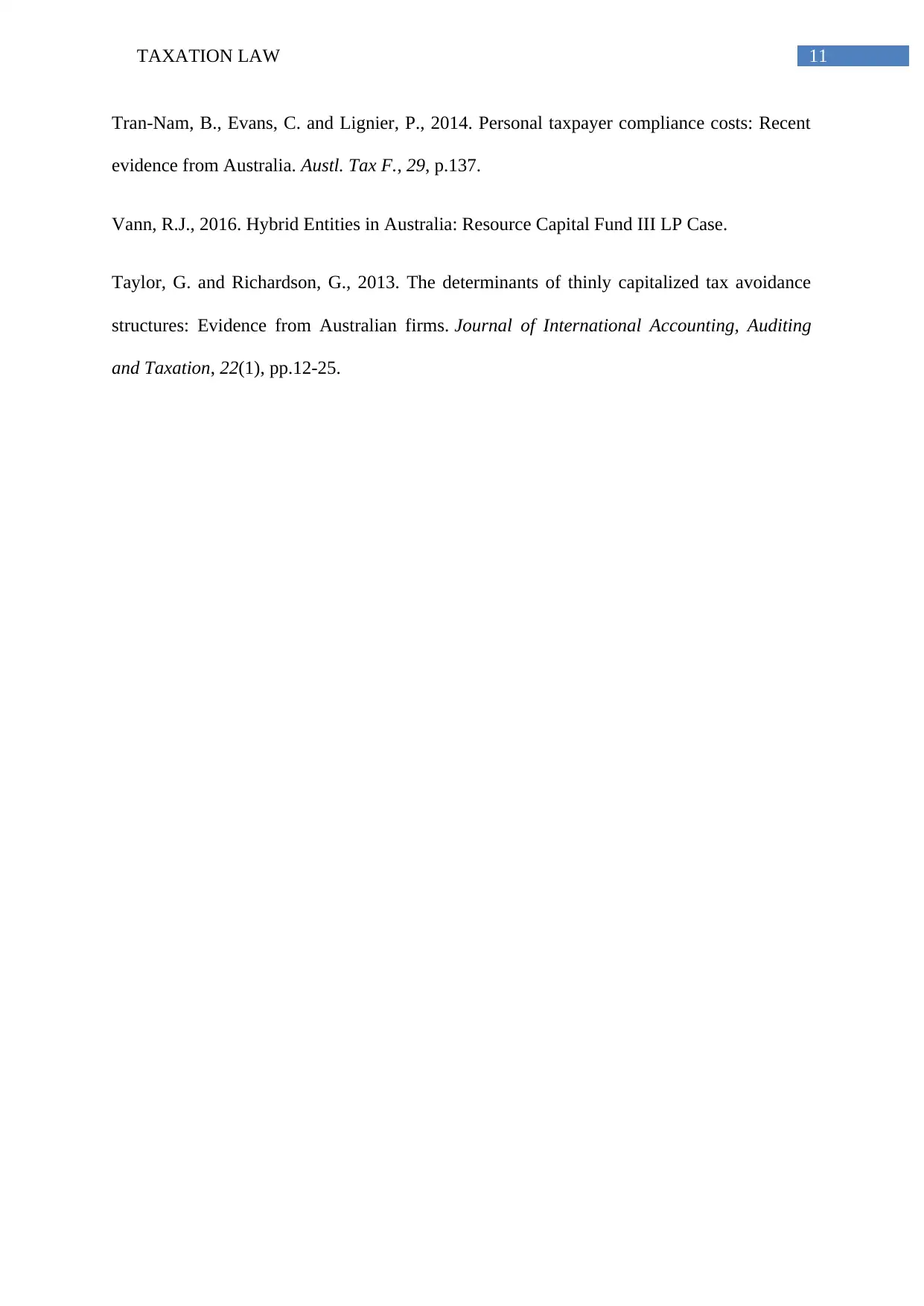
11TAXATION LAW
Tran-Nam, B., Evans, C. and Lignier, P., 2014. Personal taxpayer compliance costs: Recent
evidence from Australia. Austl. Tax F., 29, p.137.
Vann, R.J., 2016. Hybrid Entities in Australia: Resource Capital Fund III LP Case.
Taylor, G. and Richardson, G., 2013. The determinants of thinly capitalized tax avoidance
structures: Evidence from Australian firms. Journal of International Accounting, Auditing
and Taxation, 22(1), pp.12-25.
Tran-Nam, B., Evans, C. and Lignier, P., 2014. Personal taxpayer compliance costs: Recent
evidence from Australia. Austl. Tax F., 29, p.137.
Vann, R.J., 2016. Hybrid Entities in Australia: Resource Capital Fund III LP Case.
Taylor, G. and Richardson, G., 2013. The determinants of thinly capitalized tax avoidance
structures: Evidence from Australian firms. Journal of International Accounting, Auditing
and Taxation, 22(1), pp.12-25.
⊘ This is a preview!⊘
Do you want full access?
Subscribe today to unlock all pages.

Trusted by 1+ million students worldwide
1 out of 12
Related Documents
Your All-in-One AI-Powered Toolkit for Academic Success.
+13062052269
info@desklib.com
Available 24*7 on WhatsApp / Email
![[object Object]](/_next/static/media/star-bottom.7253800d.svg)
Unlock your academic potential
Copyright © 2020–2025 A2Z Services. All Rights Reserved. Developed and managed by ZUCOL.





